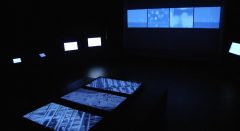 Organizing for Emergence
Organizing for Emergence
Computer vision and data mining as co-creative devices
The paper gives an account of IICSI postdoc Teresa Connor’s audiovisual installations Piano at the End of a Poisoned Stream and Cathedral.
Drawing on Jane Bennett’s theoretical position of “thing-power,” Erin Manning and Brian Massumi’s philosophical notion of “organized emergence” and Timothy Morton’s dark ecology project, I propose a series of thinking-in-the-making moves that considers the use of computer vision and data mining as co-creative and emergent devices. This research is motivated by the shift in my sonic arts practice away from fixed-media formats to the exploration of non-linear audiovisual systems.
Analogous to what Manning and Massumi call “the friends,” these accompanying influences “activate a process [and] force that acts as a differential within the ongoing movement of thought… creating an intensive passage between past and future outsides… a complex polyphony…. Thought not as already-constituted but as a force for creative thinking-feeling” (Manning and Massumi 2014, location 1241–1253). Here Manning and Massumi provide an interpretation of Gilles Deleuze’s notion of the intercessors: “the felt force that activates the threshold between thinking and feeling” (Ibid., 1243). Throughout this article these felt forces will be interwoven with how I experience, contextualize and ultimately describe the making-doing-thinking of my creative research.
To support my position, I critique two of my recent non-linear audiovisual installations, Piano at the End of a Poisoned Stream (2017) and Cathedral (2017), which emerged from field recordings in the Salton Sea and Sequoia National Park respectively. Using computer vision1 and data mining2, these works explore material agency from these situated encounters in a non-linear æsthetic. Moreover, configuring these audiovisual installations, wherein the materiality of the visuals became triggering agents, led to my considering the overall process as being organized for emergence and that such apparatus are co-creative devices. Beyond technical considerations, these ideas introduced a way of thinking and being in artistic practice that, as described by Manning and Massumi, is “an environmental mode of awareness.”
[1. I have experimented with various computer vision systems including David Rokeby’s Very Nervous System (VNS), Miroslav Spasov’s ENACTIV, Alexander Refsum Jensenius’s Motiongram, and Jean-Marc Pelletier’s cv.jit library. While all these systems offer exciting avenues of creative exploration, Pelletier’s cv.jit library is more suitable for the analysis and extraction of information from the videos in my creative research.]
[2. I use the term data mining via R. Luke Dubois, whose creative research explores the use of data that has been gleaned from real world events.]
READ the full article in issue 20.2 of CEC eContact.







